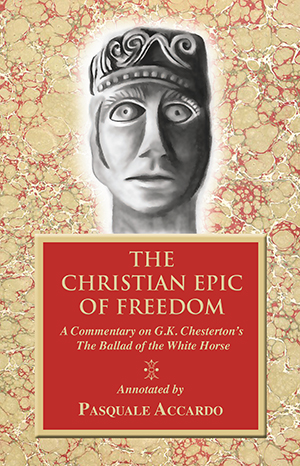



Table of Contents
Preface
Introduction
Citations
Prefatory Note
Dedication
Book One: Vision the First
Notes on “The
Vision of the King”
Book Two: Going on Crusade
Notes on “The
Gathering of the Chiefs”
Book Three: The Harpist King
Notes on “The
Harp of Alfred”
Book Four: The Cakes
Notes on “The
Woman in the Forest”
Book Five: The Throwing of the Sword
Notes on
“Ethandune: The First Stroke”
Book Six: Roncesvalle
Notes on
“Ethandune: The Slaying of the Chiefs”
Book Seven: Mother and Child: Vision
the Second
Notes on
“Ethandune: The Last Charge”
Book Eight: The Meaning of History:
Vision the Third
Notes on “The
Scouring of the Horse”
Epilogue
Appendix I: The Confusion of Alfred
and Arthur in Popular Knowledge
Appendix II: Tom Brown’s Schooldays
Appendix III: Chronology
Bibliography
The briefest summary of the present reading of The Ballad of the White Horse is that David and Alfred are types of Christ. This in turn exemplifies the philosophy of history that Chesterton expounded in his The Everlasting Man. This triune view of history is uniquely Christian. Christianity has often contrasted its conception of history as linear (with a narrative that goes from a beginning through a middle to a definite end) against the pagan myth of an Eternal Return; the latter fantasy was reanimated by Friedrich Nietzsche in the nineteenth century and then again by post-modern cosmologists for whom "what if" passes for logical argument.
The Christian view is simply that the birth, death and resurrection of Jesus Christ is the central point of all human history: everything that came before was prophecy and preparation, and everything that came after was fulfillment and reverse prophecy. If the life of Christ occupies the center, the historical epochs that preceded and followed this event can be folded over the middle panel like the right and left leaves of a triptych.1 All Christians are called to imitate Christ, to echo in their lives the drama of the Passion. Even kings from the not-so-Dark Ages.
The first complete draft of this commentary was completed in 2010 in preparation for the poem’s 2011 centennial. Its basic argument was presented at the American Chesterton Society’s thirtieth annual meeting in St. Louis, Missouri, in 2011. For a variety of reasons, the manuscript then sat on a shelf for several years. The author’s advancing age suggests that it may be time to release the work on an unsuspecting world. The original manuscript has been little amended except to include several references to works published after 2010. In no case have these additions modified the original readings of the poem.
One of the major differences between this edition of The Ballad of the White Horse and other commentaries on the poem is its emphasis on the broad range of its literary antecedents and descendants. Chesterton was deeply immersed in The Chanson de Roland, The Dream of the Rood, Chaucer, Shakespeare, Spenser, and the long tradition of English literature. T.S. Eliot, C.S. Lewis, and J.R.R. Tolkien were all familiar with and influenced by his work. As a verse masterpiece, The Ballad of the White Horse is deserving of a place in the European epic tradition. The overabundance of footnotes in this edition is intended to emphasize this judgment.2 Finally, there are many references to factual history3 as opposed to legend; these are intended to document that while Chesterton was writing legend, he never violated factual history and indeed may have given a more accurate portrait of the times than writers who restrict themselves to ‘dry facts.’
Pasquale Accardo
Other Books by the Same Author: